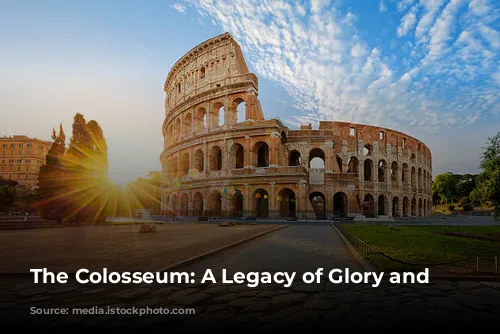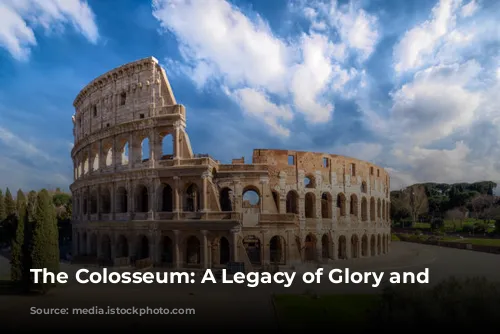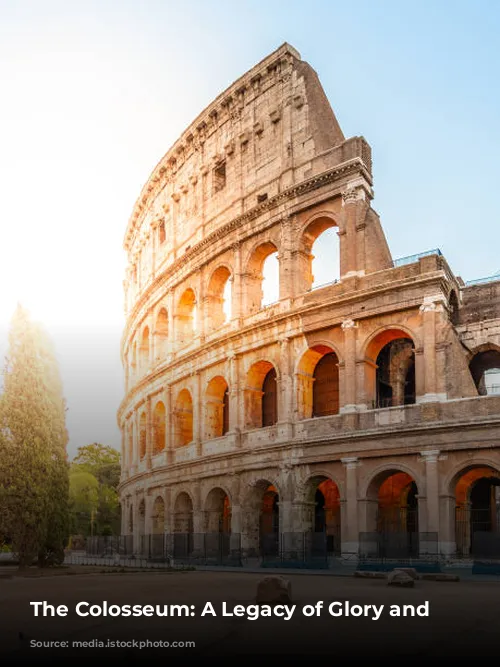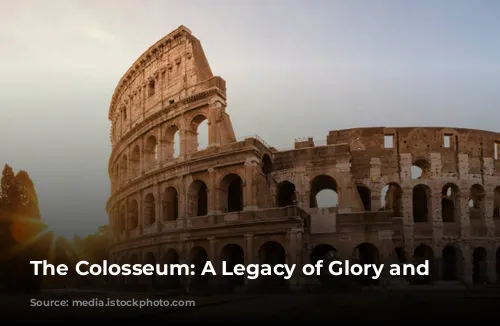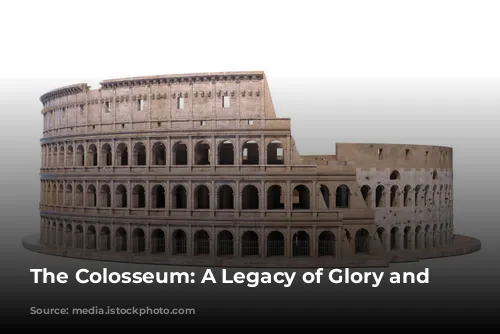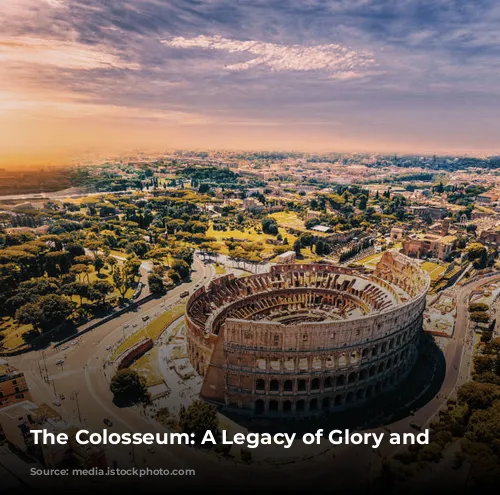The Colosseum, once known as the Flavian Amphitheatre, stands as a towering testament to Roman architectural prowess and entertainment. This massive arena, built by Emperor Vespasian and inaugurated by his son Titus in 80 A.D., was the largest and most awe-inspiring amphitheatre in the Roman Empire. Its grandeur is unmatched, captivating visitors from all corners of the globe.
A Grand Opening
The Colosseum’s inauguration was a spectacle of unparalleled extravagance, lasting an astonishing one hundred days. The Roman populace witnessed gladiatorial contests, exotic animal hunts, and even incredible naumachiae – staged sea battles that recreated famous naval confrontations from the past. Imagine the excitement and awe as thousands of spectators gathered to witness these spectacular events.
Historians believe that over 5,000 animals were slain during the opening festivities alone. The arena’s sheer size and scale were designed to accommodate vast crowds, and the elaborate performances captivated audiences with their sheer scale and daring.
The Origins of a Name
But why is it called the Colosseum? The answer lies in a famous prophecy by the medieval monk Venerable Beda. “Rome will exist as long as the Colosseum does; when the Colosseum falls so will Rome; when Rome falls so will the world,” he wrote. This prophecy, steeped in mysticism and grandeur, suggests that the Colosseum was not only a building but also a symbol of Rome’s power and resilience.
The name “Colosseum” likely originated from the colossal statue of Emperor Nero that once stood beside the amphitheatre. This immense sculpture, towering 35 meters high, was known as the Colossus, and it’s possible that the arena became associated with this impressive statue over time.
Architectural Brilliance
The Colosseum’s construction was a testament to Roman architectural mastery. Its majestic white travertine stone exterior, adorned with magnificent arches and statues, was a breathtaking spectacle. The elliptical shape of the structure maximized seating capacity, allowing for a huge audience to witness the various performances.
The Colosseum’s construction was a marvel of engineering. The Romans excelled at using the arch, a key element of their architecture, to distribute weight effectively and create structures of immense size and strength. Think of the aqueducts that carried water across vast distances – the Colosseum was a testament to this same ingenuity.
The Colosseum can be seen as a series of aqueducts stacked one on top of the other. Its intricate system of arches and supports allowed it to stand tall for centuries, weathering the ravages of time and nature.
A Timeless Arena
Sadly, much of the Colosseum’s original grandeur has been lost to time. The outer brick wall is missing three-fifths of its original structure. During the Middle Ages, the Colosseum was plundered for its valuable materials, its stones and metals used to construct other buildings like the Barberini Palace and St. Peter’s Basilica.
Even the holes that remain in many of the columns are a testament to this pillaging. They were made to extract lead and iron used for nails within the marble blocks.
A Seat for Every Citizen
The Colosseum’s capacity was staggering – 70,000 spectators could find their seats within its tiered structure. The arrangement of seats reflected the social hierarchy of Roman society. The common people occupied the upper tiers, with separate sections for men and women. As you moved closer to the arena, the seating became reserved for those of higher social standing. The front row was reserved for senators, vestals, priests, and, of course, the emperor.
Even the sun posed no threat to spectators. The Colosseum’s ingenious roof covering, known as the “Velarium,” was a vast linen tarpaulin stretched over the arena by a complex system of ropes, winches, and poles. It took 100 sailors from the Imperial fleet to maneuver this intricate mechanism, their movements synchronized to the beat of a drum.
Gladiators: Heroes and Martyrs
Stepping into the arena, one can imagine the roar of the crowd and the thrill of the games. The stage where the gladiators battled has vanished, leaving behind the cellars that once housed the equipment used for these spectacular events.
The Colosseum’s underground levels housed a system of lifts and hoists with counterweights. These mechanisms, still visible today, were used to transport animals and gladiators onto the arena floor with a spectacular flourish. Animals and gladiators would emerge from trapdoors in a sudden burst of dust, providing a dramatic element to the performances.
The gladiators were more than just performers – they were heroes, martyrs, and symbols of Roman strength. The term “gladiator” comes from “gladius,” the short sword used by legionaries. Most gladiators were prisoners of war given the choice between slavery and fighting in the arena. Some were paupers seeking fame and fortune. The profession offered not only riches but also fame and, surprisingly, admiration from women, who were known to pay handsome sums to spend time with these gladiators.
There were various types of gladiators, each with their own skills and weapons. The Retiarius, armed with a net, a trident, and a knife, was a formidable foe. Others fought with shields and sickles, while some wore crested helmets, strong armor, and carried javelins.
The gladiatorial contests were often a matter of life or death. If a defeated gladiator was wounded, he could plead for mercy by raising an arm. The crowd would then clamor for the emperor’s decision – a thumbs-up meant mercy, a thumbs-down meant death. The victor was rewarded with golden palm leaves and a substantial sum of money.
Despite the spectacle of the gladiatorial contests, the brutality and violence were undeniable. The Colosseum’s blood-soaked arena, the smell of blood and burnt flesh, and the relentless pursuit of victory all contributed to a sense of raw brutality. It was a stark reminder of the Roman Empire’s power and its capacity for cruelty.
A Timeless Symbol
The Colosseum’s legacy extends far beyond its architectural magnificence and the spectacle of its games. It has served as a reminder of Rome’s power, its enduring spirit, and its fascinating history.
In the centuries after the fall of the Roman Empire, the Colosseum fell into disrepair, serving as a source of building materials, a haven for hermits, and even a cemetery. But it was always a monument to Rome’s past, a symbol of its strength and its resilience.
Threatened with demolition in the 16th century, Pope Benedict XIV declared it a sacred monument dedicated to the Passion of Christ. A cross was placed on a pedestal, symbolizing the suffering of Christian martyrs. This cross is still the starting point for the Stations of the Cross on Good Friday.
Today, the Colosseum stands as a testament to the Roman Empire’s grandeur and its enduring impact on the world. It continues to captivate visitors from all over the globe, drawing them in to marvel at its sheer size, its architectural brilliance, and the captivating stories of the gladiators who once battled within its walls. As Charles Dickens wrote, seeing the Colosseum is like “seeing the ghost of old Rome floating over the places its people walk in.”
